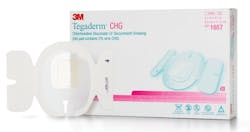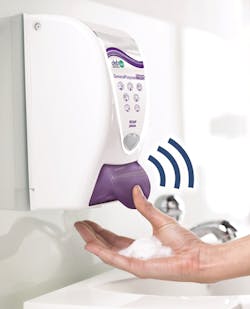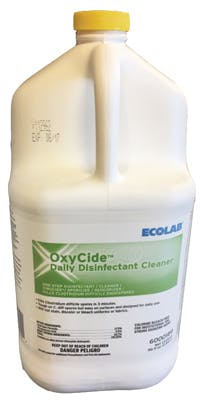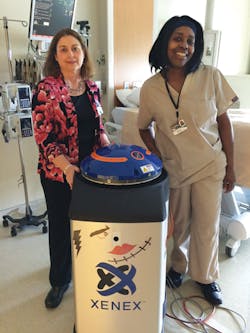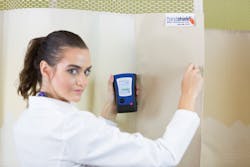When we do something right, it is often overlooked or taken for granted. Healthcare Purchasing News aims to publicly recognize professionals working in the field of infection prevention who are getting it right. Many of the victories may seem modest, but, when human lives are at stake, no success is too small to merit appreciation.
Bundling up
Ohio Children’s Hospital Association
Columbus, Ohio
Nick Lashutka, President of Solutions for Patient Safety (SPS) described SPS as a national network of more than 100 children’s hospitals working together to eliminate serious harm to patients. “SPS, launched in 2012, is the only effort in the nation specifically focused on improving pediatric care and reducing associated Medicaid costs,” explained Lashutka. It is funded, in part, by the Cardinal Health Foundation, the Children’s Hospital Association, and the federal Partnership for Patients program. Cardinal Health Foundation has contributed $4 million toward the work of SPS, plus E3 grant funding to individual hospitals within SPS for patient safety work, as well as funding and resources for ongoing training programs for hospital leadership and culture-focused work at network hospitals.
What they did: One of the 11 specific hospital-acquired conditions SPS focuses on reducing is catheter-associated urinary tract infection (CAUTI). “Since 2012, SPS has led to an estimated savings of more than $130 million and saved 6,944 children from serious harm, with a consistent upward trend in harm prevented every month, as of September 2016,” stated Lashutka.
“CAUTIs are among the most common infections in hospitals and can lead to serious complications, especially for patients who are critically ill. CAUTIs are a particular risk in children, who do not have the same hygiene as adults and who have a limited ability to understand infection prevention,” continued Lashutka.
“In January 2011, the overall CAUTI rate was approximately 2.25. SPS developed a specific protocol to reduce the CAUTI rate, including performing hand hygiene before and after insertion or manipulation of the catheter site; avoiding unnecessary catheterizations; maintaining a closed drainage system; performing perineal hygiene at least daily; keeping the bag below the level of the bladder, and removing the catheter as soon as it is no longer needed.” (SPS makes all of its bundles of care available to the public: http://www.solutionsforpatientsafety.org/wp-content/uploads/SPS-Prevention-Bundles.pdf.) SPS’ protocol also includes the use of sterile gloves, drape, and sponges; the appropriate antiseptic or sterile solution for each urethral cleaning; and the use of a single packet of lubricant jelly for each insertion.
Results: “The work to reduce the CAUTI rate is ongoing and the rate of infection has declined each year since 2012. At the end of 2015, the CAUTI rate was 1.393, a 45.55 percent overall reduction,” said Lashutka.
Methodist Hospitals
Gary, Indiana
Methodist Hospitals has 674 beds, serving Northwest Indiana and an urban population.
What they did: Michelle DeVries, MPH, CIC, Senior Infection Control Officer, identified their focus as being on “peripheral IV (PIV) policy change and PIV bundle creation, to result in improved patient outcomes by reducing bloodstream infections (BSIs) and driving efficiencies. Efforts began in February 2014 and continuous data collection persists to understand results.”
“Methodist Hospitals conducted surveillance on all lab-confirmed BSIs for the past 13 years and was aware of the inherent risks associated with PIVs,” said DeVries. “A cluster of infections in the fall of 2013 served as the impetus for reviewing opportunities to enhance PIV-related practices, products used, comprehensive staff training, and point prevalence data collection. Methodist also sought to align with updated practice standards to replace or remove PIV catheters based on clinical indication rather than routine time frames. Intense auditing of lines and education led to improvements in line care and maintenance, patient bathing, and the development of an evidenced-based PIV bundle. The bundle included a closed-system IV catheter (Nexiva, BD), sterile gloves, securement dressing, and BIOPATCH Protective Disk with CHG (Ethicon) for protection of the lines as an evidence-based product with a 7-day chlorhexidine gluconate-release profile and 360-degree coverage around the insertion site.”
Results: Results were impressive: 19 percent reduction in PIV-related BSIs (year 2: 25 percent reduction, 6 percent more than year 1); 37 percent reduction in house-wide lab-confirmed BSIs (sustained in year 2); 75 percent reduction in central-line–associated BSIs (68 percent fewer than predicted via state National Healthcare Safety Network; sustained in year 2); and 48 percent reduction in PIV-kit usage. Reduced IV sticks, positive staff and patient feedback, and having only one standard of care for peripheral and central catheters were other benefits cited by DeVries.
Select Medical
Mechanicsburg, Pennsylvania
Headquartered in Pennsylvania, Select Medical’s long-term acute-care hospital (LTACH) division manages more than 100 LTACHs specializing in medically complex cases across 33 states.
What they did: LTACH patients usually enter the facility with 10 to 15 comorbid conditions, as well as a high use of antibiotics and devices such as central catheters, putting them at a heightened risk for a central-line–associated bloodstream infection (CLABSI). Because patients arrive with a catheter already in place, the LTACHs set out to see if they could prevent CLABSI by implementing a central-catheter–maintenance bundle.
At its LTACHs, Select Medical implemented and monitored compliance of the central-catheter–maintenance bundle for six months, between August 2012 and January 2013. CLABSI rates were also monitored fourteen months before the bundle implementation and eight months after the study ended. The average CLABSI rate was 1.28 per 1,000 days with a central catheter in the six months prior to implementing the central-catheter–maintenance bundle.
The central-catheter–maintenance bundle, based on CDC’s “Guidelines for the Prevention of Intravascular Catheter-Related Infections,” focused on monitoring all likely sources of colonization during central-catheter maintenance, including patients’ skin, healthcare workers’ hands, and use of disinfectants. Staff also were required to evaluate the necessity of the central catheter daily and to follow strict processes for changing dressings, tubing, and end caps. Select Medical added mandatory use of alcohol-based central-catheter caps (3M Curos Disinfecting Port Protectors) and chlorhexidine gluconate dressings (3M Tegaderm CHG Chlorhexidine Gluconate IV Securement Dressings), and developed a team of staff members to monitor and track compliance.
Results: Select Medical’s CLABSI rates were reduced by 29 percent, at 0.96, and showed a sustained reduction over the next eight months. An average reduction of 4.5 CLABSIs per LTACH was observed for fourteen months after bundle implementation. This reduction could translate to an annual savings of $3.7 million for the 30 LTACHs studied. (For further details, see Grigonis AM, Dawson AM, Burkett M, et al. Use of a central catheter maintenance bundle in long-term care hospitals. Am J Crit Care 2016;25(2):165-172.)
Keeping it clean
Greenville Memorial Hospital
Greenville, South Carolina
Greenville Memorial Hospital is a 746-bed tertiary referral hospital and academic center serving South Carolina’s Upstate/Upcountry region.
What they did: Connie Steed, Greenville Health System Director, Infection Prevention, explained that the facility wanted to reduce risk of transmission of methicillin-resistant Staphylococcus aureus (MRSA). At the beginning of the campaign, their MRSA rate was 0.381 per 1,000 patient-days.
Over a 33-month period (July 1, 2012 to March 31, 2014), hospital staff used the DebMed Electronic Hand Hygiene Compliance Monitoring System, rather than direct observation, to measure a higher standard of hand-hygiene compliance (HHC). “The DebMed system captured data, using sensors in soap and sanitizer dispensers in 23 inpatient facilities’ nursing units, without disruption to workflow,” said Steed. When dispensers were used, “the information was sent to a server and analyzed to determine whether or not staff was adhering to the World Health Organization’s Five Moments standards.”
Steed outlined steps taken: (1) unit leadership and hand-hygiene champions were encouraged to report and discuss real-time HHC reports in daily/weekly staff and quality meetings; (2) front-line staff identified barriers to HHC, and unit-specific ideas for improvement were implemented, such as adding or relocating sanitizer dispensers, designating unit champions, and posting WHO 5 Moments diagrams above dispensers; and staff performed spot-checking of HHC through direct observation, with immediate feedback to staff regarding missed hand-hygiene opportunities.
Results: “The DebMed System’s data resulted in clinically important organizational changes and improved patient safety,” said Steed. Additional benefits included a 25.5 percent increase in HHC rates; a 42.8 percent reduction in MRSA; a savings of $433,644 achieved from avoiding the cost of additional care for twenty-four MRSA patients ($8,668 per patient) and income lost from extended hospital stays requiring 4.5 days per MRSA infection (at $2,089 per patient per day).
Steed noted, “At the conclusion, the MRSA rate was 0.267 per 1,000 patient-days, representing a 42.8 percent decrease. The success is sustained by continually monitoring MRSA infections and monitoring methods, which includes electronic hand-hygiene monitoring.” Hand-hygiene compliance has continued to improve, according to Steed. (For more details, see: Kelly JW, Blackhurst D, McAtee W, et al. Electronic hand hygiene monitoring as a tool for reducing health care–associated methicillin-resistant Staphylococcus aureus infection. Am J Infect Control. 2016;44(8):956-957.)
Piedmont Newnan Hospital
Newnan, Georgia
Piedmont Newnan Hospital, with 136 beds, provides 24-hour emergency care, plus medical, surgical, and diagnostic services, including heart care, cancer care, orthopedic care, sleep services, women’s services, and wound and hyperbaric care.
Piedmont Newnan Hospital is a recipient of the 2017 Josh Nahum Special Award for Achievement in the Infection Prevention and Control category, as part of the annual Partnership for Health and Accountability Quality and Patient Safety Award program. The award is supported by Halyard Health, in partnership with the Georgia Hospital Association.
What they did: Jeffrey Folk, MD, Chief Medical Officer at Piedmont Newnan Hospital, explained that Piedmont Newnan Hospital aimed to reduce the number of hospital-acquired Clostridium difficile infections. “As a healthcare system, our goal is to decrease all hospital-acquired infections, and, as part of this process, we recognized an opportunity to improve our C diff rates. Before the campaign started, our hospital-acquired C diff infection rate was 0.68 percent,” said Folk. The campaign started in January 2014 and ended December 2016.
Folk outlined the four-step process they developed designed to reduce C diff infections: (1) increase hand-hygiene rates; (2) improve environmental cleaning; (3) improve antibiotic stewardship, ie, giving the right antibiotic at the right time for the right duration; and (4) decrease inappropriate testing.
“At our hospital, we have cloth seats,” explained Folk, “and the cleanser used was either inappropriate for the material or ineffective. We switched to OxyCide Daily Disinfectant Cleaner (Ecolab), as it was both appropriate for the cloth material and effective against C diff spores.”
Results: The campaign paid off. “The hospital-acquired C diff rate at the end of the campaign was 0.31 percent, and we have continued to maintain this rate,” said Folk.
Habersham Medical Center
Demorest, Georgia
Habersham Medical Center (HMC) is a 53-bed acute-care facility with a full-range of healthcare services, including cardiac rehabilitation, emergency services, an exercise facility, home health, long-term care, obstetrics, occupational health, outpatient rehabilitation, a sleep-disorders center, and surgical services.
Habersham Medical Center is a recipient of the 2017 Josh Nahum Special Award for Achievement in the Infection Prevention and Control category as part of the annual Partnership for Health and Accountability Quality and Patient Safety Award program. The award is supported by Halyard Health, in partnership with the Georgia Hospital Association.
What they did: Theresa Metro-Lewis, RN, BSN, Infection Preventionist, outlined Habersham’s goal. “During 2014 through 2016, HMC began to focus on high-risk surgeries, such as total joint replacements, colon surgery, and abdominal hysterectomies. A goal was set to decrease the total number of surgical-site infections (SSIs) within the organization by 25 percent and to have an SSI rate lower than the national benchmark of 0.75 percent.”
“An SSI Team was formed to work with physician offices, the surgical-services department, and the acute-care units to create improvement efforts utilizing chlorhexidine gluconate (CHG) pre-op kits,” explained Metro-Lewis. “The kits included nares decolonization, CHG mouth rinse, toothbrush, and skin wipes.” The product, Nose to Toes, is a combination product. The 3M Company makes the nares-decolonization and mouth-rinse components, and Sage Products supplies the toothbrush and CHG bath wipes. The kit employs CHG products to clean the three main reservoirs of infection: the nose, the mouth, and the skin, to decrease the risk of infection and improve patient outcomes, according to Metro-Lewis.
Results: “HMC performs more than 2,200 surgeries annually,” continued Metro-Lewis. “Organizational data confirmed that fifty-two patients were diagnosed with SSIs from 2011 through 2013. After implementation of the new processes in 2014, only twenty-eight patients had an SSI during the next three years. HMC had zero SSIs for 669 days. The new surgical program resulted in a 47 percent reduction in total SSIs, exceeding the 25 percent goal.” Currently, the organization’s SSI rate is at 0.63 percent, whereas the national benchmark is 0.75 percent.
Olean, New York
Bradford Regional Medical Center
Bradford, Pennsylvania
Upper Allegheny Health System is the parent company of Olean General Hospital and Bradford Regional Medical Center, which provide healthcare services to 160,000 individuals throughout Southwestern New York and Northwestern Pennsylvania. Upper Allegheny provides nearly 300 beds, total, at their acute-care hospitals.
What they did: Raphael Moore, Director of Environmental Services, Olean General Hospital, said the campaign covered December 2015 through December 2016 and focused mainly on reducing rates of two organisms. “From a measurement perspective, our infection-prevention efforts were most focused on reducing Clostridium difficile and methicillin-resistant Staphylococcus aureus rates, but the decision to implement ultraviolet (UV) light was driven by a desire to enhance environmental hygiene more generally. While we already had strong infection-prevention practices in place, the environmental-services team, with the full support of hospital employees from infection preventionists to the CEO, believed that adding UV was a good way to go even further to protect patients.”
“We use three Clorox Healthcare Optimum-UV System units to enhance manual cleaning and disinfection at Upper Allegheny Health System’s two acute-care facilities, Olean General Hospital and Bradford Regional Medical Center,” stated Moore. “We implemented the UV system as an adjunct to manual cleaning and disinfection, and optimized its use based on workflow considerations, focusing on high-risk settings, including all discharge rooms in isolation areas, any discharges coming from intensive care units, and in the operating room each night after it is terminally cleaned.”
Results: According to Moore, “The results have been phenomenal since adopting the Optimum-UV System last December. C diff incidents have dropped by 8.3 percent. That said, C diff incidence is something we continue to keep a close eye on, and I’m optimistic that we will see even more significant reductions in infection rates between year two and year three.”
Riverside Medical Center
Kankakee, Illinois
Riverside Medical Center, with 318 beds, provides a full scope of inpatient and outpatient care to five rural counties.
What they did: Martha Bouk, RN, BSN, Infection Preventionist, described their approach. “Clostridium difficile was the initial pathogen we targeted, knowing that other infection rates such as methicillin-resistant Staphylococcus aureus, central-line–associated bloodstream infection (CLABSI), catheter-associated urinary tract infection (CAUTI), and surgical-site infection could also potentially be decreased. The ICU unit was chosen as a target unit, to be able to measure improvement in C diff rates.”
Bouk said Riverside’s C diff infection rates were relatively low, but their goal is zero. In 2014, they turned to pulsed xenon ultraviolet (UV) light disinfection to help achieve their goal, but first they did their homework by examining published scientific literature on Xenex technology. “The infection-rate reduction outcome studies and the full spectrum UV-light effectiveness were two major considerations in the decision, as well as the time efficiency benefits. The robot runs in five-minute cycles, so it is much faster than alternative UV technologies we evaluated.”
Staff have embraced the Xenex LightStrike Germ-Zapping Robot. “When our super-user from environmental services began disinfecting rooms with our robot, she told anyone who would listen that her rooms are not clean until the robot is done disinfecting the room.” When staff saw infection rates declining, they began to believe in the robot’s efficacy and welcomed her to take the extra couple of minutes to disinfect the rooms, observed Bouk.
Results: “The ICU is our first priority for the Xenex robot,” stated Bouk. “Hospital-onset C diff rates in the ICU decreased 57 percent from 2014 to 2015. As a result of the C diff infection reductions, we invested in an additional robot in 2016.”
The ICU CAUTI rates also dropped by 66 percent from 2014 to 2015, and the number of CLABSIs decreased in the ICU, with only one in 2015. Bouk expects the 2016 data will show that infection-rate reductions continue.
The Xenex robot was also used on another unit that experienced an increase in influenza cases. “When we began using the robot to disinfect that unit, we saw a noticeable decrease in new influenza cases after this intervention, along with all the other interventions were put in place.”
Syosset Hospital
Syosset, New York
Syosset Hospital, part of the Northwell Health system, has 136 beds and includes a special-care unit, a psychiatric wing, an emergency department that treats more than 15,000 patients each year, with a trauma unit and eight treatment beds.
What they did: “According to Medicare, Syosset Hospital was in the highest index for Clostridium difficile and had high healthcare-acquired infection (HAI) rates,” said Lorenz “Buddy” Mayer, Assistant Director of Support Services, North Shore University Hospital, part of the Northwell Health system. “In 2012, the index was 11.3; in 2013, the index was 10.8.”
Syosset Hospital began their campaign against C diff in late 2013 and ended in late 2014. Their focus was on patient-room curtains as a source of pathogens. “Studies on curtains were published showing high and frequent presence of HAI-related microbes, including C diff,” noted Mayer. “We tried to wash the curtains ourselves, but the results of wrinkling, long wait times, and dry-cleaning were too expensive and unsuitable. We used a professional company to clean our curtains, but the requests for curtain changes and cleaning became more frequent.”
Mayer developed the idea/concept of the Hand Shield, a permanent attachment on the curtains that allows high-touch areas to be wiped down by environmental-services employees as part of the existing high-touch room-cleaning policy. Syosset Hospital used the cleanable Hand Shield from Curtain Care Plus that was developed by Mayer. “In addition to having the curtains professionally cleaned and doing other measures to reduce the high index of C diff at Syosset Hospital, Syosset used the Hand Shield, by Curtain Care Plus,” explained Mayer. “Wiping down the curtains daily resulted in a significant decrease of cross-contamination and spread of HAIs throughout the hospital.”
Results: Mayer said that, at the end of the study, according to the National Healthcare Safety Network, Syosset’s C diff index for 2014 dropped to 2.55. “That rate has remained consistent, and Syosset Hospital has been able to sustain the reduced rate of infection.” In 2015, the C diff index was 4.20, and, in 2016, the C diff index was 2.67 (January–September, 2016). “In addition to other HAI reduction measures, the Hand Shield has been implemented system-wide and has resulted in the system being able to avoid the Medicare reimbursement penalties that so many hospitals have experienced.”
About the Author

Susan Cantrell
Susan Cantrell is Infection Prevention Editor for Healthcare Purchasing News.



